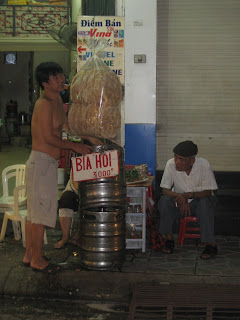Just north of the Lao border the Mekong river contains thousands of tiny islands with no electricity or running water, and apart from tourism no industries except (rice) farming and fishing. We stayed for a few days on one of the larger islands, Don Deth, doing very little except cycling around the paddy fields, avoiding the water buffalo which had wandered onto the paths, and lazing around in hammocks for a few days.

After finally dragging ourselves out of our hammocks we left the island and continued north to see some caves at Ban Kong Lor. A songthaew (pick-up truck with two benches in the back for seats) dropped us off at the cave entrance and from there we got into a small wooden boat which took us along the river that runs through the caves for 5km and out the other side. Afterwards, we spent the night at a homestay in the village and provided free entertainment for the local children.

After so much time in the countryside, Vientiane, the capital 'city' of Laos (population 500,000) seemed like quite a metropolis. We got very excited about cheese baguettes and french wine for a couple of days, although we are converted to drinking Lao-style coffee (served strong and sweet with a shot of condensed millk) and of course Beerlao. While we were in Vientiane we made a pilgrimage to the Beerlao factory, where we were rewarded with a tour of the factory, free beers, and a calendar featuring lots of lovely Lao ladies.

We weren't so keen on our next stop, Vang Vieng, which seemed like the Lao equivalent of Ibiza. Everyone comes here to go 'tubing' – floating down the river on inner tubes, stopping at lots of bars on the way, where the staff throw ropes which you use to haul yourself in whenever you want a drink. When they aren't tubing, everyone sits in bars drinking 'happy shakes' and watching Friends DVDs on repeat all day.

After escaping Vang Vieng we went to Luang Prabang, the ancient capital of Laos with lots of beautiful old Wats (buddhist temples) to explore and a much more peaceful atmosphere. Naturally we shattered this along with our new friends John and Gem by going out drinking past the curfew and having to wake up the (heavily pregnant) hostel owner to get back in. The four of us also went on a daytrip out of town to visit a waterfall and a local bear sanctuary. This turned into a bit of an adventure when just a few miles out of town we found a tree had fallen, completely blocking the road. We resigned ourselves to having to turn back but instead the enterprising tuk tuk drivers encouraged their passengers to squeeze through a gap under the tree and swap into tuk tuks stuck on the other side. This way everyone got to continue their journeys without having to wait hours for the road to be cleared.

Our final stop before crossing into Vietnam was Phonsavanh, also known as the Plain of Jars. The jars were left behind by an unknown ancient civilization; the latest theory is that they were used as funeral urns, but we much prefer the local superstition that they were used to distill massive amounts of lao-lao, the local alcoholic drink. This part of Laos is the most heavily bombed region of Laos, and Laos is the most heavily bombed nation on earth, perhaps the most surprising thing is that the bombing (by the USA) took place while they were not officially at war. There are lots of unexploded cluster bombs still lying around and there are warnings at all of the jar sites not to step away from the marked paths. Other local 'points of interest' include bomb craters and a cave where hundreds of people sheltered from the bombing raids. People here use bomb shells as ornaments, plant pots and foundation posts for their houses.



 Our last stop before leaving for Tibet was Leshan, where we fought through the throngs of Chinese tourists to see the world's largest sitting Buddha statue.
Our last stop before leaving for Tibet was Leshan, where we fought through the throngs of Chinese tourists to see the world's largest sitting Buddha statue.













